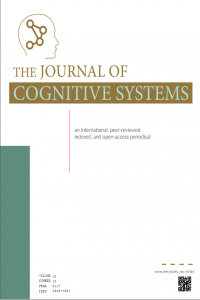Abstract
References
- [1] Subrahmanyam, K., & Greenfield, P. (2008). Media symbol systems and cognitive processes. In S. Calvert & B. J. Wilson (Eds.), The Blackwell handbook of children, media, and development (pp. 166 –187). London: Blackwell Publishing.
- [2] Terlecki, M. S., Newcombe, N. S., & Little, M. (2008). Durable and generalized effects of spatial experience on mental rotation: Gender differences in growth patterns. Applied Cognitive Psychology, 22, 996 – 1013.
- [3] Haykin,-S. Cognitive Dynamic Systems Cambridge University Press, (2010). COST2102, Spain, Sept. 2009 (Haykin).
- [4] McClurg, P. A., & Chaille´, C. (1987). Computer games: Environments for developing spatial cognition. Journal of Educational Computing Re- search, 3, 95–111.
- [5] Green, C. S., & Bavelier, D. (2006a). The cognitive neuroscience of video games. In L. Humphreys & P. Messaris (Eds.), Digital media: Trans- formations in human communication (pp. 211–223). New York: Peter Lang Publishing.
- [6] Green, C. S., & Bavelier, D. (2006b). Effect of action video games on the spatial distribution of visuospatial attention. Journal of Experimental Psychology: Human Perception and Performance, 32, 1465–1478.
- [7] Green, C. S., & Bavelier, D. (2006c). Enumeration versus multiple object tracking: The case of action video game players. Cognition, 101, 217– 245.
- [8] Kramer, A. F., & Hahn, S. (1995). Splitting the beam: Distribution of attention over noncontiguous regions of the visual field. Psychological Science, 6, 381–386.
- [9] Lepsien, J., & Nobre, A. C. (2006). Cognitive control of attention in the human brain: Insights from orienting attention to mental representations. Brain Research, 1105, 20 –31.
- [10] Maccoby, E. E., & Jacklin, C. N. (1974). Psychology of sex differences.
- [11] Stanford, CA: Stanford University Press.
- [12] Rolls, E. T. (2008). Top-down control of visual perception: Attention in natural vision. Perception, 37, 333–354.
- [13] Universal Principles of Design, Revised and Updated, by William Lidwell, Kritina Holden & Jill Butler.
Abstract
A degree in cognitive science provides the opportunity
to work in many fields of human and technology. For instance, cognitive science
can be used within usability and design, game development, vehicle, road
safety, patient safety, technical aids, speech and dictation, technical writer
and other forms of processing. Computer game enthusiasts spend many hours in
the game, and this intense activity can change the brain and behavior. We
consider the studies, which investigate the ability video games to change processes
in spatial knowledge in this study. We will outline the initial stages research
of the basic mechanisms of training, and also we will consider possible
applications this new knowledge. Several experiments have shown that the game
of gaming action causes changes in a number of sensory, perceptual and
attention that are important for many tasks in spatial cognition.
Keywords
Video game action Spatial attention Learning perception Gender differences Brain training Sensory processes Attentıon processes
References
- [1] Subrahmanyam, K., & Greenfield, P. (2008). Media symbol systems and cognitive processes. In S. Calvert & B. J. Wilson (Eds.), The Blackwell handbook of children, media, and development (pp. 166 –187). London: Blackwell Publishing.
- [2] Terlecki, M. S., Newcombe, N. S., & Little, M. (2008). Durable and generalized effects of spatial experience on mental rotation: Gender differences in growth patterns. Applied Cognitive Psychology, 22, 996 – 1013.
- [3] Haykin,-S. Cognitive Dynamic Systems Cambridge University Press, (2010). COST2102, Spain, Sept. 2009 (Haykin).
- [4] McClurg, P. A., & Chaille´, C. (1987). Computer games: Environments for developing spatial cognition. Journal of Educational Computing Re- search, 3, 95–111.
- [5] Green, C. S., & Bavelier, D. (2006a). The cognitive neuroscience of video games. In L. Humphreys & P. Messaris (Eds.), Digital media: Trans- formations in human communication (pp. 211–223). New York: Peter Lang Publishing.
- [6] Green, C. S., & Bavelier, D. (2006b). Effect of action video games on the spatial distribution of visuospatial attention. Journal of Experimental Psychology: Human Perception and Performance, 32, 1465–1478.
- [7] Green, C. S., & Bavelier, D. (2006c). Enumeration versus multiple object tracking: The case of action video game players. Cognition, 101, 217– 245.
- [8] Kramer, A. F., & Hahn, S. (1995). Splitting the beam: Distribution of attention over noncontiguous regions of the visual field. Psychological Science, 6, 381–386.
- [9] Lepsien, J., & Nobre, A. C. (2006). Cognitive control of attention in the human brain: Insights from orienting attention to mental representations. Brain Research, 1105, 20 –31.
- [10] Maccoby, E. E., & Jacklin, C. N. (1974). Psychology of sex differences.
- [11] Stanford, CA: Stanford University Press.
- [12] Rolls, E. T. (2008). Top-down control of visual perception: Attention in natural vision. Perception, 37, 333–354.
- [13] Universal Principles of Design, Revised and Updated, by William Lidwell, Kritina Holden & Jill Butler.
Details
| Primary Language | English |
|---|---|
| Journal Section | Research Article |
| Authors | |
| Publication Date | December 1, 2017 |
| Published in Issue | Year 2017 Volume: 2 Issue: 2 |

